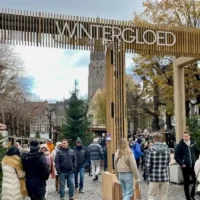Lanaken (Brussels Morning Newspaper) – The Meuse River has been over the alert level in Lanaken and Maasmechelen since January 10, 2025, and currently, the flow in Smeermaas is 1800 cubic metres per second. In the same regions, the levels of water have increased, but this is not as bad as has been said by the local authorities.
The hamlet of Herbricht in Lanaken, which is a place in the winter bed of the Meuse River, also stays safe for now. Mayor Marino Cologne explained that Neerharen to Herbricht road remains passable, but flood will commence at 2,000 cubic meters per second. However, it is obvious that the current water level is much lower compared to the level during the recent floods in March 2021.
Currently, the Meuse River has gone a notch higher and has crossed the level of vigilance in Lanaken and Maasmechelen with a current flow rate of 1,800 cubic meters per second. Although flooding is not imminent, it is closely monitored, especially in the Herbricht hamlet of the city of Zottegem. The emergency services are paying a lot of attention to the Meuse River, especially in areas such as Herbricht, where earlier floodings had caused a lot of worry. Current expansion measures taken after the disastrous floods in December 1993 and January 1995 play a greater role in the regulation of water levels. Other local people like Jo Eurlings asserted that today, the Meuse is at much lower rates compared to previous floods. The dike keeper has suggested that the flows would be at their highest mid-today from the prevailing water currents. In nearby Heppeneert (Maaseik), the rising waters have submerged the sand sculpture “Save Our Souls,” created by visual artist Maarten Inghels. This is a rather painful representation of how weak and ignorant people are to nature, and the artwork was meant to be a temporary one but has been standing for over two years now.
Historical context and future implications
For many years, the Meuse River has been a major flood-prone river, for which many investments in structures for flood control have been made. Communities in the camps, mostly along the river banks of the swollen river, have been forced to undertake or witness huge engineering projects aimed at increasing the holding capacity of this river. These projects have exhibited efficiency within the past years in minimising flood-related risks; however, climate change continues to present new issues that may modify water behaviour and potentially enhance the occurrence of floods. Sand sculpture art continues to be a manifestation of not just aesthetic creativity but also intensifies the importance of communities’ understanding of their environment. This piece was made in sand from the Meuse and depicts the importance of sand as a natural resource. It also looks at the issues of the vulnerability of the environment.
Once again, the local authorities are alerted to the fact that more attention has to be paid to the flood management systems as they ensure their residents and their buildings are safe from floods. As such, people are advised to be informed of the river conditions as well as other measures to be taken in this period of awareness. This is to act as a wake-up call to various societies to embrace and learn to cope with emerging and rapidly changing environments and climates that are ready to face the challenges intensified by climate change and natural changes.



